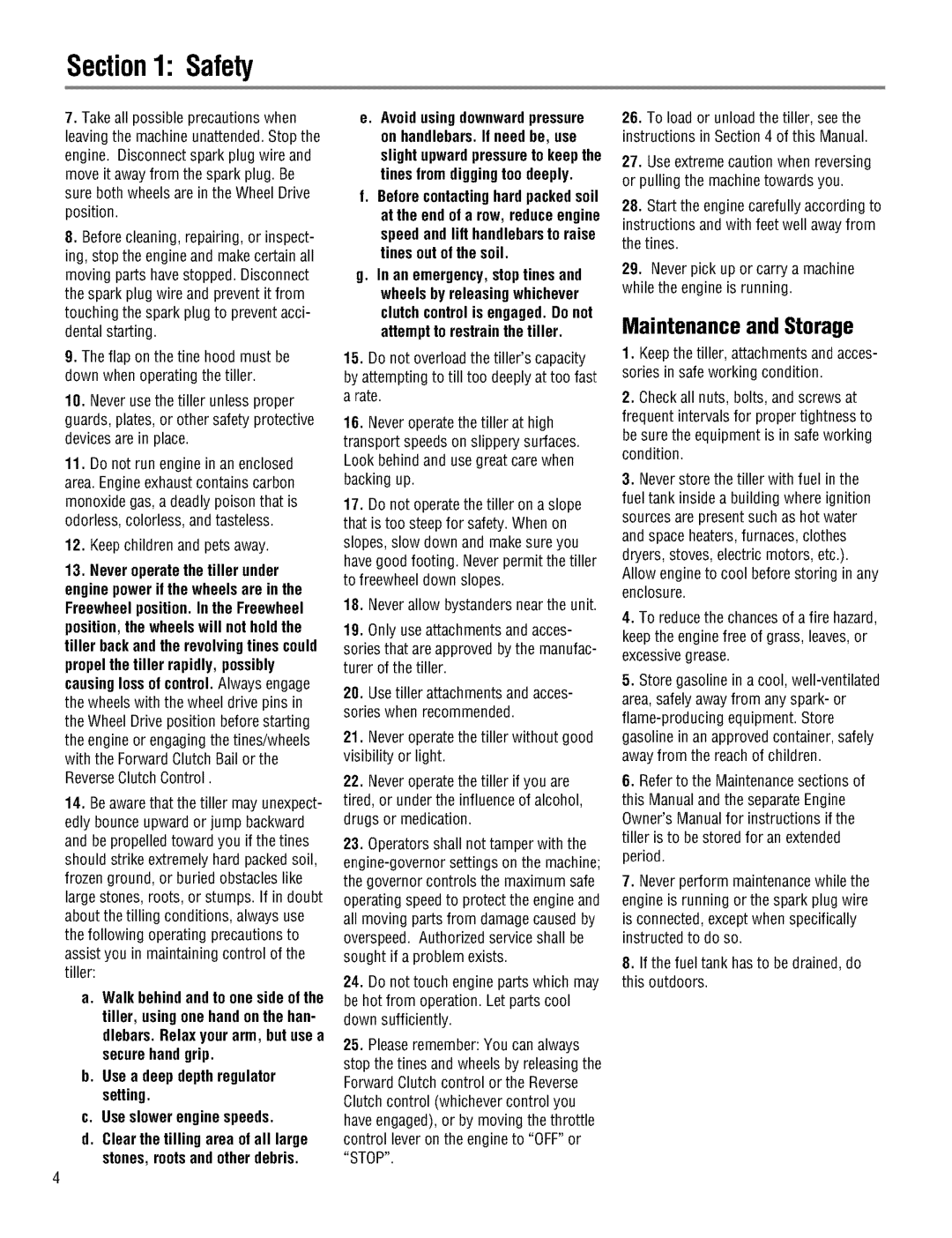
Section1: Safety
7.Takeall possible precautions when leavingthe machineunattended. Stop the engine. Disconnect spark plug wire and move it awayfrom the spark plug. Be sure both wheels are in the Wheel Drive position.
8.Before cleaning, repairing, or inspect- ing, stop the engineand makecertain all moving parts havestopped. Disconnect the spark plug wire and prevent it from touching the spark plug to prevent acci- dental starting.
9.The flap on the tine hood must be down when operating the tiller.
10.Never usethe tiller unless proper guards, plates, or other safety protective devices are in place.
11.Do not run engine in an enclosed area. Engineexhaust contains carbon monoxide gas,a deadly poison that is odorless, colorless, and tasteless.
12.Keepchildren and pets away.
13.Never operatethe tiller under engine powerif the wheels are in the Freewheel position. In the Freewheel position,the wheels will not hold the tiller backand the revolvingtines could
propelthe tiller rapidly, possibly causing loss of control.Always engage the wheelswith the wheel drive pins in the Wheel Drive position before starting the engine or engaging the tines/wheels with the Forward Clutch Bailor the ReverseClutch Control.
14.Beaware that the tiller may unexpect- edly bounce upward or jump backward and bepropelled toward you if the tines should strike extremely hard packedsoil, frozen ground, or buried obstacles like largestones, roots, or stumps. If in doubt about the tilling conditions, always use the following operating precautionsto assist you in maintaining control of the tiller:
a.Walk behindand to one side of the tiller, using one handon the han- dlebars. Relax your arm, but use a secure hand grip.
b.Use a deep depthregulator setting.
c.Useslower engine speeds.
d.Clear the tilling area of all large stones, rootsand other debris.
e.Avoid using downwardpressure on handlebars.If need be, use slight upward pressureto keep the tines from diggingtoo deeply.
f.Beforecontactinghard packedsoil at the end of a row, reduceengine speed and lilt handlebarsto raise tines out of the soil.
g.In an emergency, stoptines and wheels by releasing whichever clutchcontrolis engaged. Do not attemptto restrain the tiller.
15.Do not overload the tiller'scapacity by attempting to till too deeply at too fast a rate.
16.Neveroperate the tiller at high
transport speeds on slippery surfaces. Look behind and use great care when backing up.
17.Do not operatethe tiller on a slope that is too steepfor safety. When on slopes, slow down and makesure you have good footing. Never permit the tiller to freewheel down slopes.
18.Neverallow bystanders nearthe unit.
19.Only use attachments and acces-
sories that areapproved by the manufac- turer of the tiller.
20.Usetiller attachments and acces- sories when recommended.
21.Neveroperate the tiller without good visibility or light.
22.Neveroperate the tiller if you are tired, or underthe influenceof alcohol, drugs or medication.
23.Operatorsshall not tamper with the
24.Do not touch engine parts which may be hot from operation. Let parts cool down sufficiently.
25.Pleaseremember: You can always stop the tines and wheels by releasingthe Forward Clutch control or the Reverse
Clutch control (whichever control you have engaged), or by moving the throttle control lever on the engineto "OFF"or "STOP".
26.To load or unload the tiller, seethe instructions in Section4 of this Manual.
27.Useextreme caution when reversing or pulling the machinetowards you.
28.Startthe engine carefully according to instructions andwith feet well awayfrom the tines.
29.Neverpick up or carry a machine while the engine is running.
Maintenance and Storage
1.Keepthe tiller, attachments and acces- sories in safe working condition.
2.Checkall nuts, bolts, and screws at frequent intervals for proper tightness to besure the equipment is in safeworking condition.
3.Neverstore the tiller with fuel in the fuel tank inside a building where ignition sources are present such as hot water and space heaters,furnaces, clothes dryers, stoves, electric motors, etc.). Allow engine to cool before storing in any enclosure.
4.To reduce the chancesof afire hazard, keepthe enginefree of grass, leaves,or excessive grease.
5.Store gasoline in a cool,
6.Referto the Maintenancesections of
this Manual and the separate Engine Owner'sManualfor instructions if the tiller is to be stored for an extended period.
7.Neverperform maintenancewhile the engine is running or the spark plug wire is connected,except when specifically instructed to do so.
8.If the fuel tank hasto be drained, do this outdoors.
